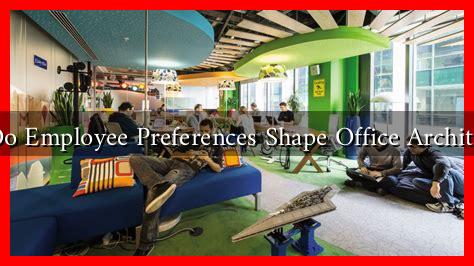-
Table of Contents
How Do Employee Preferences Shape Office Architecture?
In the modern workplace, the design and architecture of office spaces are increasingly influenced by employee preferences. As organizations strive to enhance productivity, foster collaboration, and improve employee satisfaction, understanding these preferences has become essential. This article explores how employee preferences shape office architecture, highlighting key trends, examples, and the implications for businesses.
The Shift Towards Employee-Centric Design
Traditionally, office spaces were designed with a focus on functionality and aesthetics, often neglecting the needs and preferences of employees. However, the rise of the knowledge economy and the increasing importance of employee well-being have prompted a shift towards employee-centric design. This approach prioritizes the needs and preferences of employees, leading to more effective and engaging work environments.
Key Employee Preferences Influencing Office Design
Several employee preferences significantly impact office architecture. Understanding these preferences can help organizations create spaces that enhance productivity and satisfaction. Some of the most notable preferences include:
- Flexibility: Employees increasingly prefer flexible workspaces that can adapt to various tasks, from collaborative projects to focused work. This has led to the rise of open-plan offices, breakout areas, and multi-purpose rooms.
- Natural Light: Access to natural light is a top priority for many employees. Studies have shown that natural light can improve mood, increase productivity, and enhance overall well-being.
- Collaboration Spaces: With the growing emphasis on teamwork, employees favor spaces that facilitate collaboration. This includes informal meeting areas, lounges, and communal workspaces.
- Health and Wellness: Employees are increasingly concerned about their health and well-being. Features such as standing desks, ergonomic furniture, and wellness rooms are becoming essential in office design.
- Technology Integration: As remote work becomes more prevalent, employees prefer offices equipped with advanced technology that supports seamless communication and collaboration.
Case Studies: Successful Employee-Centric Office Designs
Several companies have successfully implemented employee-centric office designs that reflect the preferences of their workforce. Here are a few notable examples:
- Google: Known for its innovative office spaces, Google incorporates flexible work areas, relaxation zones, and ample natural light. Their offices feature open layouts, collaborative spaces, and even recreational facilities, all designed to enhance employee satisfaction and productivity.
- Airbnb: Airbnb’s headquarters in San Francisco is designed to reflect its culture of community and collaboration. The open floor plan encourages interaction among employees, while various themed meeting rooms provide unique spaces for brainstorming and creativity.
- WeWork: As a pioneer in flexible workspaces, WeWork designs its offices to cater to the diverse needs of its members. With a focus on community, their spaces include collaborative areas, private offices, and event spaces, all designed to foster interaction and creativity.
The Role of Employee Feedback in Office Design
To create an office environment that truly reflects employee preferences, organizations must actively seek and incorporate employee feedback. Surveys, focus groups, and informal discussions can provide valuable insights into what employees value most in their workspaces. By involving employees in the design process, companies can ensure that their office architecture aligns with the needs and preferences of their workforce.
Conclusion: The Future of Office Architecture
As the workplace continues to evolve, employee preferences will play an increasingly vital role in shaping office architecture. By prioritizing flexibility, natural light, collaboration, health, and technology, organizations can create work environments that enhance productivity and employee satisfaction. The successful case studies of companies like Google, Airbnb, and WeWork demonstrate the positive impact of employee-centric design on organizational culture and performance.
In summary, understanding and integrating employee preferences into office architecture is not just a trend; it is a necessity for businesses aiming to thrive in the competitive landscape of the modern workplace. As we move forward, organizations that prioritize employee needs will likely see improved engagement, retention, and overall success.
For more insights on workplace design and employee preferences, you can explore resources from the Gartner HR Insights.

